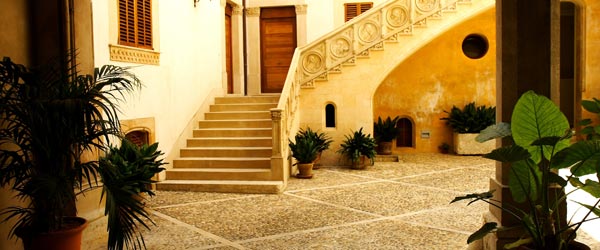Palma, a city of courtyards
Palma de Mallorca, the capital of the Balearic Islands, is a city bathed in sunlight that offers a constant store of surprises. Its hallmarks are its maritime atmosphere and its rich cultural heritage, which can be perfectly seen in the courtyards to be found in the stately houses that abound in the old town. These are large houses with beautiful architecture that are symbols of Palma's identity. Come and discover them on this very special route.
Majorca is a privileged destination with close to 550 kilometres of coastline, where you'll find some of the most beautiful beaches and coves in the Mediterranean. It is also home to an outstanding artistic heritage with monuments such as Bellver Castle and Palma Cathedral. Here we suggest some other more unusual –but equally charming– sites to explore: the courtyards to be found around the city, which have led many to call Palma the city of courtyards.
You can see them all on a walk through the old town or by following the special route organised to celebrate Corpus Christi.
More than forty courtyards
The beauty and unique nature of Palma's courtyards once captivated Jules Verne, who made them the setting for his protagonists' adventures in "Clovis Dardentor".
There are over forty courtyards scattered around the centre of Palma, many of which are located in public institutions such as the Museum of Contemporary Spanish Art, the Palau March Museum, the High Court or the hospital of San Pere i San Bernat.
Others, such as Can Oleza and Can Sureda, are private houses and their courtyards can only be seen through the gates, except during the Corpus Christi celebrations.
They all provide a glimpse of the island's rich architectural heritage and offer a faithful reflection of Palma's history. The courtyards sometimes also serve as the venue for classical music concerts.
The origins of Palma's courtyards go back to the Roman period, but they gained in importance from the 13th century on. They were initially more austere, in the Gothic style, but the economic boom of the 17th and 18th centuries brought a far more luxurious and ornate decoration in the Renaissance and Baroque styles.
Special route during the Corpus Christi celebration
During Corpus Christi, a religious celebration that takes place in May and June, there is a special guided route around Palma's 40+ courtyards on a walking tour through the centre of the city that takes barely two hours.
Another option is to visit them without a guide.
Here we suggest some of the courtyards not to be missed on your route: Can Berga, home to the High Court, is the largest of Palma's courtyards, and where it is particularly worth noting the imperial staircase that links its three tiers.
The courtyard of Oleza Palace, one of Palma's most beautiful buildings, and Can Vivot, with its red-coloured marble columns, are both fine examples of Baroque style.
Can Pásquela has a mixture of styles with a 20th-century staircase, neo-Gothic windows and Baroque columns.
Ca la Gran Cristina is the site of the Majorca Museum; Can Marquès has a clearly Modernist influence; Can Lladó is medieval in origin; Marquès del Palmer boasts a stunning Renaissance façade; and Can Catlar del Llorer and Can Alemany both have courtyards which reveal their Gothic origins.







